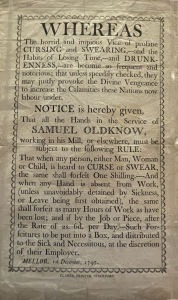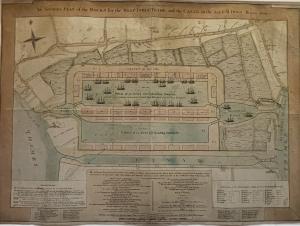This is part of a series of blog posts highlighting objects and archival documents from Social Climates: Power and the Environment in the Archives, an exhibition currently on view in the Kempner Gallery at Columbia’s RBML. Drawing on a wide array of RBML collections and materials, Social Climates explores the interconnections between culture, history, politics, and the natural world.
The following is adapted from the Social Climates exhibit essay text by Melina Moe, Curator of Literature and Bernadette Myers, Lecturer in the Department of English and Comparative Literature. Read more about how the environmental humanities is changing archival interpretation in their co-written article or visit the online exhibition.
Cotton shaped modern capitalism and changed how we think about the natural world. Fueling the growth of global trade, cotton was harvested by slave labor in the US plantation economy and processed by industrial factories in the UK. This section of the Social Climates exhibit features items from the Oldknow-Arkwright archive, which combines the papers of Samuel Oldknow, the first large-scale domestic manufacturer of lightweight cotton cloth in England, and Richard Arkwright, inventor of the spinning frame.
Focused on Oldknow’s (ultimately unsuccessful) effort to build one of the first textile factories, these papers illuminate the far-reaching consequences of raw cotton exchange. Oldknow’s business knitted together global systems of imperial power and enslavement, and local environments of resource exploitation and technological innovation. Waterways were monopolized, canals connected interior lands to burgeoning ports, and industrial sectors built previously sleepy agricultural towns.
“Notice to Employees,” 1797, Samuel Oldknow Papers.
Henry Lewis, Cotton Plantation. Eine Baumwoll-Pflanzung, 1850. George Plimpton Papers.
“The Plan of the Docks for the West India Trade” and the Peak Forest Canal Permits reveal the increasingly elaborate infrastructure for bringing raw goods to Britain’s factories and transporting finished goods to domestic and international markets and Henry Lewis’ engraving, “A Cotton Plantation,” illustrates that British manufactures and consumers were well aware of the human cost of their burgeoning industrial textile sector.
John Fairbun, An Accurate Plan of the Docks for the West India Trade and the Canal in the Isle of Dogs, 1801. Historical Map Collection
Social Climates runs through September 30, 2022 in Kempner Gallery at Columbia’s RBML, 6th Floor Butler.


